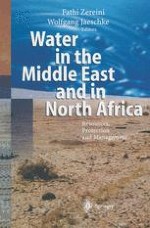2004 | OriginalPaper | Chapter
Water Utilization in Semi-Arid Zone, The Hula Valley (Israel): Pollutant Removal, Agriculture and Ecotourism Management
Author : Moshe Gophen
Published in: Water in the Middle East and in North Africa
Publisher: Springer Berlin Heidelberg
Included in: Professional Book Archive
Activate our intelligent search to find suitable subject content or patents.
Select sections of text to find matching patents with Artificial Intelligence. powered by
Select sections of text to find additional relevant content using AI-assisted search. powered by
Until the late 1950’s the Hula Valley (altitude: 62.00–70.00 m above MSL) was covered by old Lake Hula (1.5 m mean depth; 13 km2 water surface), 3500 ha was a swampy area mostly covered by dense vegetation of Cyperus papyrus (85%) and partly by Phragmites australis (ca 10%) and the rest by different aquatic plants, including cattail (Typha domingensis). The swampy area was completely water-covered in winter and partly covered in summer The bottom sediments underneath the swamps vegetation were comprised of organic peat, nitrogen rich, under reductive conditions covered by water with low of oxygen content and probably anoxic during the night. The most common nitrogen form in Lake Hula waters and in the swamps was ammonia whilst nitrate was mostly below detection limit (Dimentman et al. 1992). Northern to the swamps there was an area (3200 ha) where water table levels were high in winter time, making agricultural development impossible. During summer periods, when underground water level declined these 3200 ha, were successfully (economically) cultivated.
